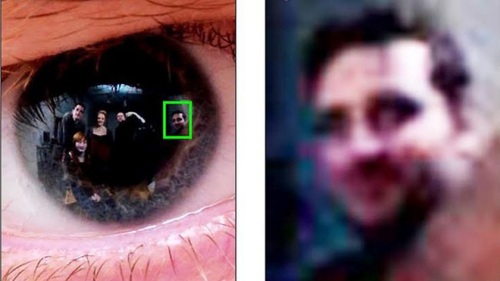Here’s looking at you, kid: researchers studying the high level of detail that modern-day digital photographs can provide have stated that they’re able to pick out the tiny reflections of faces that are otherwise normally hidden in the eyes of the subject, and identify who they belong to with a rather high level of accuracy.

“The pupil of the eye is like a black mirror,” said Rob Jenkins, of the Department of Psychology at the University of York. “To enhance the image, you have to zoom in and adjust the contrast.”
He adds: “A face image that is recovered from a reflection in the subject’s eye is about 30,000 times smaller than the subject’s face.”
Jenkins, in working with Christie Kerr (School of Psychology, University of Glasgow), was able to recover numerous images of bystanders from several subjects’ eyes; some of the faces captured were as small as 27 pixels wide.
When these faces were presented to panelists in a face-matching task, observers were able to match the bystanders’ faces, on average, 71% of the time.
When any of the faces were familiar to the panelist, they were able to recognize the person’s identity 84% of the time.
“Our findings thus highlight the remarkable robustness of human face recognition, as well as the untapped potential of high-resolution photography,” Jenkins said.
For those curious, the experiment used a high-end 39-megapixel Hasselblad camera and the bystanders’ facial images were taken while the onlookers were close to the subject and the room well lit; that is, these photos were captured in ideal settings.
Now, that being said, the argument can be made that as smartphones continue to pack higher level digital sensors into their cameras, the day will soon come where this level of specificity will be in the hands of the common man, and the settings need not be ideal in order to capture such detail.
And while that might sound like a bad thing, experts suggest it could actually be good, stating that crimes in which victims are photographed (e.g. hostage takings, child kidnappings, etc.) reflections in the eyes of the victims could help identify the perpetrators.
Jenkins and Kerr published their research in the open-access journal, PLoS ONE.
Story via foxnews.com
Advertisement
Learn more about Electronic Products Magazine





